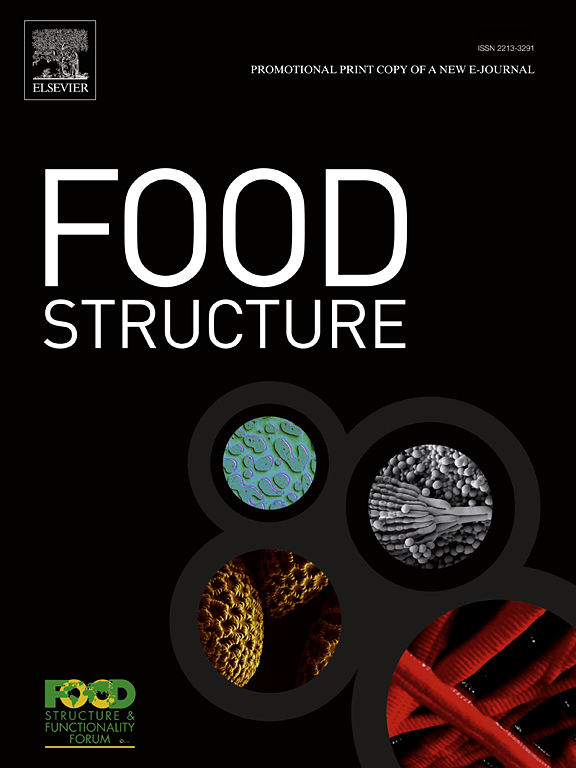大豆蛋白水解微凝胶稳定皮克林凝胶状乳剂负载槲皮素的制备、包封及保护
IF 5.9
3区 农林科学
Q1 FOOD SCIENCE & TECHNOLOGY
引用次数: 0
摘要
采用不同ph值(3、5、7和9)下合成的不同大豆蛋白水解微凝胶(SPHM)颗粒和超声波(300 W, 5 min)制备了含50 wt%油相的Pickering凝胶状乳状液。存储稳定性和低温扫描电镜分析表明,ph7条件下的SPHM (SPHM pH 7)颗粒稳定凝胶状乳状液在4℃储存21天内,通过紧密的液滴结构保持稳定,液滴体积更小,液滴之间的静电斥力更强,具有更高的热力学稳定性和粘弹性,差示扫描量热法(DSC)和流变性能结果证明了这一点。随后,选择ph7凝胶状SPHM乳状液给药槲皮素,进一步评价其体外环境稳定性和消化性能。结果表明,在pH为5、0.2 M NaCl条件下,槲皮素乳液凝胶具有较高的稳定性和槲皮素包封效率(EE),而加热和冻融处理会导致油滴聚集,导致乳液不稳定。体外消化实验表明,与分散在散装油中的槲皮素相比,凝胶状乳状液的包封加速了游离脂肪酸的释放,提高了生物可及性约120 %。该研究表明,sphm稳定的凝胶状乳剂可能是疏水生物活性物质的潜在递送系统。本文章由计算机程序翻译,如有差异,请以英文原文为准。
Preparation, encapsulation and protection of quercetin loaded in Pickering gel-like emulsions stabilized by soy protein hydrolysate microgel particles
Pickering gel-like emulsions containing a 50 wt% oil phase were prepared using different soy protein hydrolysate microgel (SPHM) particles synthesized at various pHs (3, 5, 7, and 9) and ultrasonication (300 W, 5 min). Storage stability and cryo-scanning electron microscopy analyses showed the SPHM at pH 7 (SPHM pH 7) particle stabilized gel-like emulsion was stable via closely spaced droplet structures, contained smaller droplets and exhibited stronger electrostatic repulsion between the droplets within 21 days of 4 ℃ storage, with a higher thermodynamic stability and viscoelasticity, as proved by the differential scanning calorimetry (DSC) and rheology properties results. Subsequently, the SPHM pH 7 gel-like emulsion was chosen to delivery quercetin, then its environmental stability and digestive properties in vitro were further evaluated. The results showed quercetin-loaded emulsion gel demonstrated higher stability and encapsulation efficiency (EE) of quercetin at pH 5 and 0.2 M NaCl was used, while the heating and freeze–thawing treatments caused the aggregation of oil droplets and instability of emulsions. In vitro digestion revealed the encapsulation of gel-like emulsion accelerated the release of free fatty acids and improved bioaccessibility by approximately 120 % compared with quercetin dispersed in bulk oil. This study indicate that SPHM-stabilized gel-like emulsions could be potential delivery systems for hydrophobic bioactives.
求助全文
通过发布文献求助,成功后即可免费获取论文全文。
去求助
来源期刊

Food Structure-Netherlands
Chemical Engineering-Bioengineering
CiteScore
7.20
自引率
0.00%
发文量
48
期刊介绍:
Food Structure is the premier international forum devoted to the publication of high-quality original research on food structure. The focus of this journal is on food structure in the context of its relationship with molecular composition, processing and macroscopic properties (e.g., shelf stability, sensory properties, etc.). Manuscripts that only report qualitative findings and micrographs and that lack sound hypothesis-driven, quantitative structure-function research are not accepted. Significance of the research findings for the food science community and/or industry must also be highlighted.
 求助内容:
求助内容: 应助结果提醒方式:
应助结果提醒方式:


